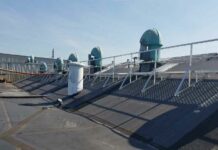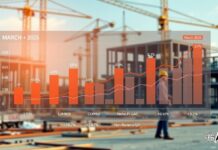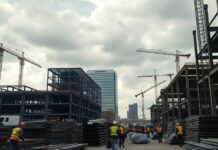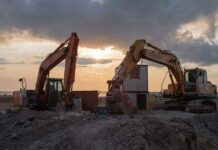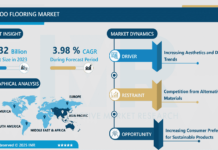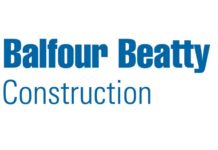The construction industry in the US is entering a period that is engulfed with profound uncertainty in 2025. It is shaped by the far-reaching effect when it comes to new tariffs on construction in US, consistent inflation, and an intricate interplay of strengths and weaknesses, which is witnessed in sectors.
As the sector continues to grapple with these headwinds, shareholders from various developers as well as contractors and even suppliers, along with policymakers, should embrace a landscape where game rules are changing at a very fast pace. Let us delve into how these forces are changing the market, with special focus on the effects as far as the Trump administration’s 2025 tariffs are concerned, the transitioning housing and residential sectors, and also the critical role that steel plays in the construction supply chain.
2025 steel tariffs by Trump – changing the construction economics
It is well to be noted that in February 2025, the US government came up with sweeping 25% tariffs on all imported steel as well as aluminum, thereby removing the erstwhile exemptions and product-specific exclusions. This sort of a police shift has gone on to have a very urgent and dramatic impact on construction costs. Since the industry depends very heavily on these materials, right from the reinforcing bars to structural frames,.
The new tariffs on construction in US have gone on to impact almost $19 bn when it comes to annual construction steel imports, therefore sending The prices of rebars are soaring by over 26% to $1240 a ton. Only this has added more than $14,000 when it comes to the cost of a building, which is a typical single-family home.
Notably, domestic steel producers have gone on to respond by ramping up their output, with production scaling to 8% year-to-date. But this increase has not been enough when it comes to offsetting the loss of imports, and even fabrication bottlenecks have become quite an issue. There are many fabricators that are reporting delays and even cancellations as they happen to struggle to secure raw materials that are affordable, with lead times when it comes to architectural metals stretching anywhere between 14 and 18 weeks.
This has led to some developers redesigning the projects or even accepting costs that are higher, thereby fundamentally making alterations to the calculus of construction planning.
Gains that are fragile amidst policy shifts in residential construction
It is worth noting that the residential construction sector is indeed feeling the pinch of the material cost increase, which is compounded by the high rate of interest and ongoing regulatory apprehension. The National Association of Home Builders’ housing market index, also known as HMI for April 2025, clocked 40, which is indeed a slight improvement from the month of March, but it’s still well below the 51 figure that was recorded in April last year. It is suggested that any reading that is below 50 signals pessimism when it comes to builders, and the present figure goes out to reflect a market that is predominantly weighed down due to labor volatility, rising costs, and hesitancy in consumers.
Also, the housing starts in March 2025 dipped steeply to a seasonally altered annual rate of 1.324 million, which was down almost 11% from February. Although it is still up 1.9% from 2024. This year-over-year gain goes on to break a series of five consecutive dips; however, the underlying momentum still remains weak.
It is well to be noted that the single family starts happened to be hit the hardest and fell 14.2% from February, which is almost 10% from the previous year. Permits, which go on to serve as a leading indicator when it comes to future construction, jumped very slightly to 1.482 million but continued their year-over-year dip for the seventh consecutive month.
The fact is that builders are becoming growingly cautious as 68% have already reported project delays because of supplier renegotiations that have been triggered due to new tariffs on construction in US. There are many builders who are postponing the start until later this year just in the hope that there will be some kind of relief when it comes to material prices. They are also hopeful that there might as well be some clarity when it comes to regulations.
Interestingly, the squeeze is especially acute when it comes to entry-level homes, where the added costs coming from tariffs and rising mortgage rates have made many projects financially unviable. Although the multifamily permits have seen a very slim uptick, driven by incentives for high-density development, the total picture is one of hesitation and, of course, uncertainty.
Data centers that defy the broad slump in the non-residential sector
The non-residential sector goes on to present a very nuanced picture with major divergence across subsectors. According to the Dodge Momentum Index, which is a leading indicator when it comes to non-residential building planning, non-residential construction fell 6.9% in March to a figure of 205.6, thereby reflecting a wide slowdown as far as project planning is concerned. Commercial construction, especially, has been hit hard, with warehouse planning going down 11% month over month and retail storefronts dipping 14% as the spending of consumers weakens. Institutional construction also happens to be under a lot of pressure, with healthcare planning dipping for the first time ever since 2021 and even education projects declining as states redirect their funds.
But not everything is bleak. The data center construction remains a bright spot, which is pretty rare, as planning activity is up 23% year over year and now comprises a quarter of all commercial planning.
There are large-scale projects such as the Bessemer, Ontario, convention center and the Alabama data center whose expansion is moving forward due to demand when it comes to digital infrastructure as well as government incentives. There are government facilities that have also seen a slight rise when it comes to planning, thereby reflecting a post-pandemic throttle in terms of modernizing public buildings and complying with the new workplace benchmarks.
In spite of these resilience pockets, the entire trend looks negative. The American Institute of Architects billing index has gone on to register a reading of 45.5 in February this year, thereby marking a consecutive 14-month contraction. There are regional disparities that are very evident, with the Northeast going ahead and experiencing the highest rate when it comes to project cancellations and the West faring marginally better because of the demand in data centers. The gap when it comes to project inquiries and the contracts that have been signed has broadened considerably to almost 7 months, which is indicative of a market in which uncertainty as well as risk aversion go on to dominate the decision-making process.
A mix of domestic boom with fabrication bust – The story of Steel
There is no shred of doubt when we say that the steel market happens to be at the heart of the present challenges that are faced by the construction industry. While the domestic production has seen an increase to 94 mn when it comes to response to the tariff, fabrication capacity has actually dipped, with numerous firms not able to absorb the higher costs or passing them onto the customers. All this has led to a solid mismatch between the finished product supply and raw materials that are needed. There are warehouse lead times that are tripling from 3 to 9 weeks. Almost half of the fabricators report ordering cancellations, and the industry is indeed grappling with $4.2 billion when it comes to an inventory that is stranded since the projects are either delayed or getting abandoned.
This sort of supply chain disruption has indeed had ripple effects throughout all the construction segments. The rising cost as well as scarcity of steel products has gone on to force some of the developers to either redesign projects, substitute materials, or go ahead with starts that are delayed. The effect is especially severe when it comes to large steel-intensive projects, such as manufacturing plants, infrastructure upgrades, or warehouses. Even the sectors that are less dependent on steel, like residential construction, are also feeling the heat since higher costs when it comes to HVAC systems, fasteners, and other components work their way across the supply chain.
HVAC as well as water heaters – bright spots in the storm
In the middle of these challenges, there are certain areas of growth as well. The market when it comes to heat pumps as well as energy-efficient water heaters has gone up, with shipments when it comes to heat pumps growing 8% quarter over quarter to almost 4 million units. This kind of growth happens to be driven by a combination of federal tax credits, exemptions from the new tariffs on construction in US as far as Energy Star-certified products are concerned, and state-level building code alterations. In contrast to this, only the traditional HVAC shipments have seen a dip of 11% year over year, underscoring a major shift when it comes to consumer as well as builder preference towards some more sustainable technologies.
The 2025–2026 Outlook: Going through uncertain waters
Marching forward, the US construction industry’s outlook happens to be highly contingent when it comes to macroeconomic and policy developments. If we talk of a baseline scenario, the Federal Reserve can very well cut rates by 50 basis points by the end of this year, thereby offering some kind of relief to borrowers and thereby potentially balancing construction spending at a slight .8% yearly growth. But if inflation remains the way it is and rates keep on being elevated, recession looms large. In such a scenario, GDP could as well contract in the third quarter, and non-residential construction starts could dip by almost 20%, and even the industry could lose hundreds of thousands of jobs.
There also happens to be a more optimistic scenario. Where bipartisan push offers targeted tariff relief as well as new infrastructure spending gets unlocked by helping housing starts to rebound and even the non-residential construction to recover. But this outcome looks less likely due to the present political situation.
Strategic requirements for survival
In the present situation, construction firms are going ahead and adopting a series of strategies in order to manage risk levels and maintain competitiveness. There are many who happen to be localizing their supply chain, with almost three-quarters mandating domestic sourcing when it comes to structural steel as well as key components. There are regional material hubs that are getting established in order to decrease the lead times and maintain a buffer against any kind of supply shocks. Contract innovation happens to be on the rise, with almost 90% of the novel agreements such as tariff escalation clauses.
It is well to be noted that productivity enhancement also happens to be one of the key focus areas. There are firms that are investing in AI-driven estimating tools in order to manage volatile pricing in a better way and even adopt modular construction techniques so there can be a reduction in labor demands, and at the same time, the project timelines can get accelerated. The embracement of modular methods has over the period of time doubled in the past two years by reaching 14% of the market share in 2025.
In the end
The construction industry in the US in 2025 happens to be standing at a crossroads, facing unmatched barriers due to new tariffs, transitioning demand patterns, and also inflation. It is residential construction, which is indeed struggling under the weight of high prices as well as tight financing. Whereas the non-residential sector may as well face some divergent fortunes, all thanks to data centers and government projects coming up.





